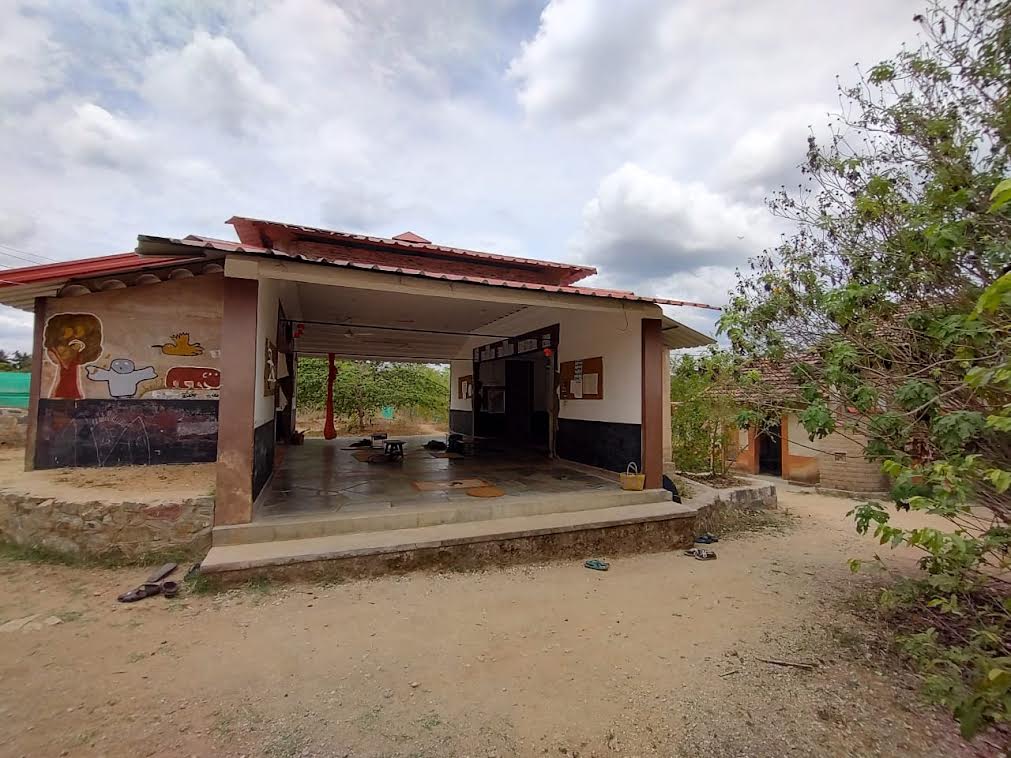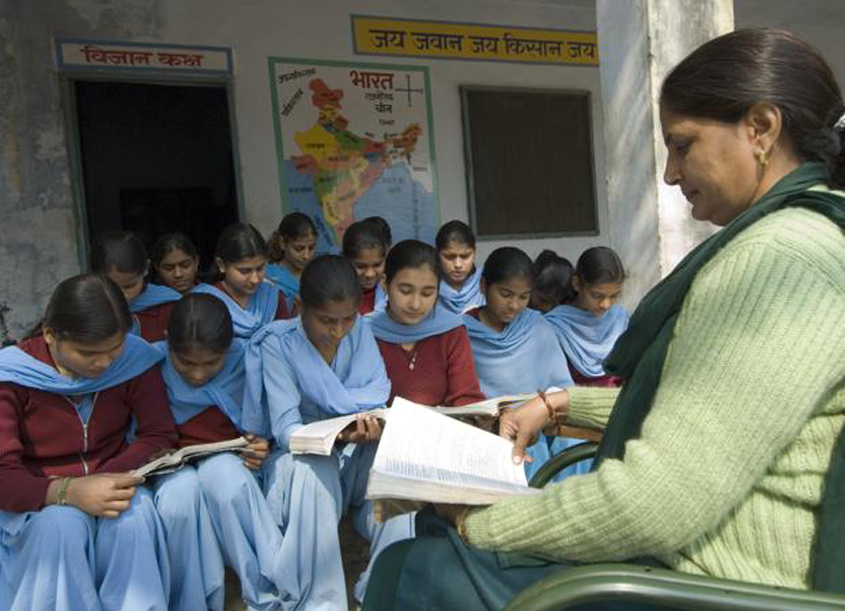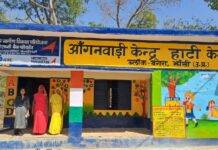Thulir is a school – it is a thoughtfully created environment that engages with the learning needs of children who live in Sittilingi. Sittilingi lies in a valley surrounded by the Kalrayan and Sitheri hills, in Dharmapuri district. It is home to twenty-one Malayalee (adivasi) hamlets, two Lambadi hamlets and a dalit hamlet.

Set up first as an after-school learning cum resource centre for government school students, Thulir worked full-time with adolescent students marginalised by these traditional schooling systems. Thulir aimed to be a space that was both accessible and meaningfully useful to these learners. It engaged the students in basic technology courses that would then enable them to work on real life projects in the villages, primarily to do with architecture, building and farming, thus creating worthwhile opportunities of learning. In 2014, with growing need and requests from the community, Thulir was set up as a school that now functions for learners from ages 4 to 10. The beginnings of Thulir point adequately to the motivations behind creating what the school can be characterised as – a caring, compassionate space of learning.
When thinking of schools, one would naturally envision these to be spaces marked by care. An imagination in contrast to this would be considered appalling. Yet, a glimpse of the high levels of competition and the constant use of negative reinforcements that we often see in school settings could make one wonder about how much attention is paid to conceptualising the role of care within schools and classrooms.
A framework that helps us think about care in classrooms is offered by the field of care ethics. Care ethics is rooted in the belief that relations are basic to humans and that the aim of education is to help build dispositions that enable us to engage in caring relations (Noddings, 2012). Caring relations are marked by, among other values, attentiveness and responsiveness (Mochinski, 2010) and grounded in dialogue. In a caring relation, the carer is attentive to the needs of the cared-for and the attention is receptive – it wants to understand the needs. These values enable that the need approached then is not an assumed need but an actually expressed need. And these needs are communicated, consistently, within a framework of dialogue that is rooted in listening carefully and compassionately.
Thulir offers us an example of what this relation could look like.
It is with multiple visits over years, through conducting surveys and talking to the people in Sittilingi, that Anu and Krishna, architects/educators, set up Thulir Resource and Learning Centre to engage learners who the mainstream system of education was failing. As an
after-school programme, Thulir was intended to be a safe space that offered basic academic skills through meaningful learning experiences. The rationale followed through as the school was set up almost a decade later. The architecture, the pedagogy, the stakeholder relationships and the general attitude towards learning are all markers of this.
When one sees the children at Thulir in their school environment, a great sense of ease can be felt. The school seems like a very natural extension of their everyday lives; learning at Thulir is organised around life in the community. At its core, the school aims to provide education that is not alienating from the culture of the communities but places great value on the context that the learner comes from. One of the first morning activities for the younger children at school is a morning nature walk in the nearby forest, guided by a teacher who spends the time showing them trees and plants of relevance, alongside exploring other things. The whole school joins in for a longer forest-walk every Friday.
The architecture of the school is of defining importance to how the space is set up. Built using locally sourced materials, drawing from local and sustainable practices and primarily by those who were part of the after-school programme, the building structures of the school are an example of what accessible school spaces could look like. Most of the walls double either as blackboards or canvasses for painting. The grills of the windows and doors have been framed to show fractions, shapes or other sequences or serve as an abacus-like counting device, using old bolts in the place of beads. On the floors of the classrooms for the younger children are painted streams, with fish, whales and octopus in them. Besides these smaller details, the rooms themselves are more than adequately ventilated and have lots of space for the students to move in, out and around. These are structures that not only enable but also encourage children to both explore and express themselves, offering them the freedom to do so, within safety.
The morning assembly is another engagement where learning happens alongside great excitement. At the assembly, children and teachers alike sing aloud songs and poems in Tamil and English, often with actions. Following this is a routine reminder – by a younger and an
older child together – of the date and temperature in the area – all marked on a blackboard. On the day we visited, we witnessed a conversation that began with the temperature in Sittilingi and went on to what zero degrees celsius would feel like and further, what minus degrees would feel like, who Eskimos are and where igloos are found.
An ecosystem of connection
The nature of the relationships that each of the stakeholder groups share are also notable. There are multiple affirmations of a shared sense of belongingness and purpose in how each of these groups take part in the functioning of the school. The teacher- learner is marked by a feeling of warm consideration but also one that acknowledges the learners as curious individuals in their own right. The teachers are often referred to as ‘anna’/‘akka’ (meaning older brother/ sister in Tamil). They take part in the morning singing and dancing routines fairly as much as the children do. Everyone eats lunch together in an open dining area, after having, in chorus, thanked those who cooked food for them.

In their decision-making, Thulir is primarily a teacher-run school with a majority of the teachers belonging to the local communities. The teachers play a defining role in deciding what is taught and how it is done. The teachers are joined by the parents who are also constantly a part of the running of the school. There are frequent meetings which discuss the functioning of the school that the parents play a role in. It is from this sort of an engagement that a decision was made that the parents’ contribution to their child’s learning at Thulir need not be monetary, but instead, could be through contributions in kind. These include participating in different functions, like aiding with the construction work or by contributing to the food needs at school, usually by supplying produce. The functioning of the school is also strongly supported by families who have moved into Sittilingi, working in different capacities and roles, never exclusively but always offering a hand wherever the need arises.
The school is not without its share of challenges. These are sometimes fair challenges, like thinking about ways to introduce critical thinking frameworks and questions into conversations, alongside some other unfair ones, like being caught up in the red tapes of obtaining registrations for a school that does not function according to traditional, rigid
expectations of how a school should be run. However, choosing to tackle these collectively and thereby, by staying true to the values that motivated the setting up of a space like this is inspiring.
When put together, all these elements add up to the creation of a meaningful school experience where learning happens through engagement with the environment and is not limited to the four walls of a classroom. Schooling, as a process, aims to initiate young individuals into the ways of living of the communities that surround them. It is only right then, to envision education as contextual, as rooted in the day-to-day lives of the learners. This contextuality goes beyond questions of what is learnt to how it is learnt and what the general environment of learning should be. At the foundation then, of creating meaningful learning experiences, lies an attempt to truly understand and engage with a context and to do so means to care.
References
Noddings, N. (2012). The caring relation in teaching. Oxford Review of Education, 38(6), 771–781. https://doi.org/10.1080/03054985.2012.745047
Gilligan, C. (1993). In a different voice: Psychological theory and women’s development. Harvard University Press.
Monchinski, T. (2010). Critical Pedagogies and an Ethic of Care. Counterpoints, 382, 52.
.
Riya Dominic, Research Associate, Azim Premji University










